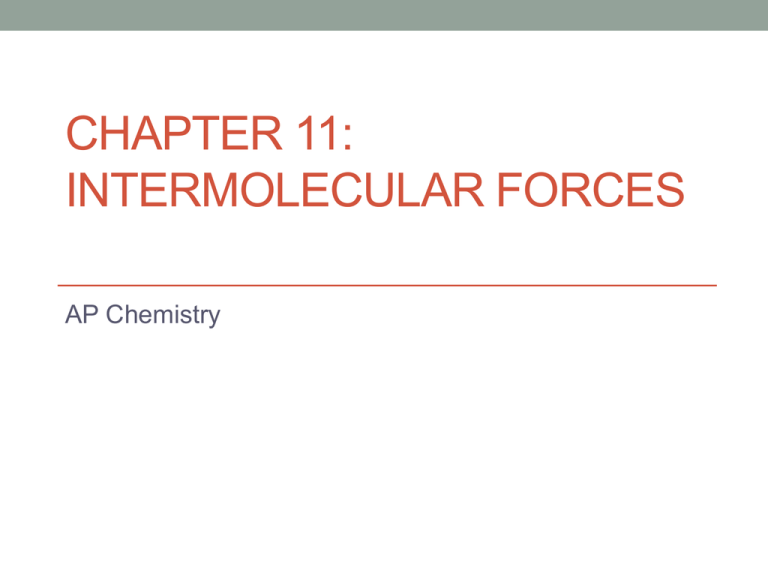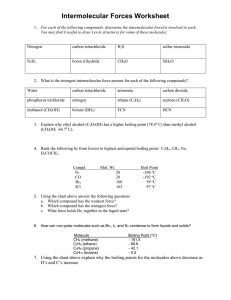Chapter 11: Intermolecular forces
advertisement

CHAPTER 11: INTERMOLECULAR FORCES AP Chemistry States of Matter • The fundamental difference between states of matter is the distance between the particles States of Matter • The state of a substance is in at a particular temperature and pressure depends on two antagonistic entities: The kinetic energy of the particles The strength of the attractions between the particles Intermolecular Forces • The attractions between molecules are not nearly as strong as the intramolecular attractions that hold compounds together • They are, however, strong enough to control properties such as boiling and melting points, vapor pressures, and viscosities • These intramolecular forces are: • London Dispersion Forces • Dipole-Dipole Interactions • Hydrogen Bonding • ** Ion-Dipole Interactions • The first 2 above are referred to as Van der Waals forces London Dispersion Forces • While the electrons in the 1s orbital of helium repel each other (and, therefore, tend to stay far away from each other), it does happen that they occasionally wind up on the same side of the atom. • At that instant, then, the helium atom is polar, with an excess of electrons on the left side and a shortage on the right side London Dispersion Forces • Another helium nearby, then, would have a dipole induced in it, as the electrons on the left side of helium atom 2 repel the electrons in the cloud on helium atom 1. • London dispersion forces, or dispersion forces, are attractions between an instantaneous dipole and an induced dipole • LDF present in all molecules, whether polar or nonpolar • The tendency of an electron cloud to distort in this way is called polarizability Factors Affecting London Forces (polarizability) • The shape of the molecule affects the strength: long, skinny molecules (like n-pentane) tend to have stronger dispersion forces than short fat ones (like neopentane) • This is due to the increased surface area in n-pentane • The strength of dispersion forces tends to increase with molecular weight. • Larger atoms have larger electron clouds which are easier to polarize. Dipole-Dipole Interactions • Molecules that have permanent dipoles (polar molecules) are attracted to each other. • The positive end of one is attracted to the negative end of the other and vice-versa • These forces are only important when the molecules are close to each other Dipole-Dipole Interactions • The more polar the molecule, the greater the dipole-dipole intereractions, so its boiling point is higher Which Have a Greater Effect: DipoleDipole or LDF? • If two molecules are of comparable size and shape, dipole-dipole interactions will likely be the dominating force. • If one molecule is much larger than another, dispersion forces will likely determine its physical properties Boiling Points as a Function of Molecular Weight • The BP of the group 4A (bottom) and 6A (top) hydrides are shown as a function of molecular weight. • In general, the BP increase with increasing molecular weight because of the increasing strength of dispersion forces How Do We Explain This? • The nonpolar series SnH4 to CH4 follow the expected trend. • The polar series follows the trend from H2Te through H2S, but water is an anomaly • This is due to… Hydrogen Bonding • The dipole-dipole interactions experienced when H is bonded to N, O, or F are unusually strong. • We call these interactions hydrogen bonds. • Hydrogen bonding arises from the high electronegativity of N, O, and F. • Also when hydrogen is bonded to one of those elements, the hydrogen nucleus is exposed (very positive side of compound) Ion-Dipole Interactions • A fourth type of force, ion-dipole interactions, are an important force in solutions of ions. • The strength of these forces are what make it possible for ionic substances to dissolve in polar solvents. Summarizing Intermolecular Forces Predicting the Types and Relative Strengths of Intermolecular Forces • List the forces involved in each substance then list in order of increasing boiling points: • Barium Chloride • Hydrogen molecule • Carbon Monoxide • Hydrogen Fluoride • Neon Solution • H2<Ne<CO<HF<BaCl2 • Attractive forces are stronger for ionic substances than molecular. • BaCl2 should be highest • The intermolecular forces of the remaining substances depend on molecular weight, polarity, and hydrogen bonding. • H2 lowest –nonpolar and lowest molecular weight (LDF) • Ne – nonpolar, higher molecular weight than H2 (LDF) • CO, HF, molecular weights are roughly the same. (LDF, D-D) • HF also has hydrogen bonding (LDF, D-D, HB) Practice Substance Boiling Point Water, H2O 100C Ammonia, NH3 -33C Methane, CH4 -164C In terms of intermolecular forces, account for the differences in the boiling points in the above table. Water and ammonia have higher boiling points than methane because water and ammonia form hydrogen bonds and methane does not. Hydrogen bonds are relatively strong intermolecular bonds and require more energy to separate them. Water has a much higher boiling point than ammonia because water has two nonbonding pairs of electrons per molecule versus one nonbonding pair for ammonia. Also, oxygen is more electronegative than nitrogen. Therefore, the hydrogen bonding in water is much stronger than that in ammonia. Intermolecular Forces Affect Many Physical Properties • The strength of the attractions between particles can greatly affect the properties of a substance or solution. • Viscosity • Surface tension • Boiling point Viscosity • Resistance of a liquid to flow • Related to the ease with which molecules can move past each other. • Viscosity increases with stronger IMF and decreases with higher temperature. Surface Tension • Results from the net inward force experienced by the molecules on the surface of a liquid • These are COHESIVE forces • Cohesive forces are forces bind similar molecules to one another • Adhesive forces bind a substance to a surface • Capillary action • miniscus Phase Changes Energy Changes Associated with Changes of State • Heat of Fusion: Energy required to change a solid at its melting point to a liquid. ∆Hfus • Heat of Vaporization: Energy required to change a liquid at its boiling point to a gas. ∆Hfus • Notice that the heat of vaporization is always larger than the heat of fusion 1. Heating Curves • The heat added to the system at the MP and BP goes into pulling the molecules farther apart from each other. • The temperature of the substance does not rise during the phase change • For Water: • ∆Hfus = 6.01 kJ/mol • ∆Hvap = 40.7 kJ/mol Calculating ∆H for Temperature and Phase Changes • Calculate the enthalpy change upon converting 1 mol of ice at -25.0 C to water vapor at 125 C under a constant pressure of 1 atm. • The specific heats of ice, water, and steam are 2.09 J/g-K, 4.18 J/g- K, and 1.84 J/g-K respectively. • For water, ∆Hfus = 6.01 kJ/mol and ∆Hvap = 40.67 kJ/mol • Heating stages: q = cm∆T/1000 • Phase changes: q = (∆Hfus/vap) (mol) Answer • Solid phase: q = (2.09 J/g-k) (18.01g) (25 C) / 1000 = 0.941 kJ S-L phase change: q = (6.01 kJ/mol) (1 mol) = 6.01 kJ Liquid phase: q = (4.18 J/g-K) (18.01g) (100 C) / 1000 = 7.528 kJ L-G phase change: q = (40.67 kJ/mol) (1 mol) = 40.67 kJ gas phase: q = (1.84 J/g-K) (18.01g) (25 C) / 1000 = 0.828 kJ Total = 0.941 + 6.01 + 7.528 + 40.67 + 0.828 = 56.0 kJ Practice • What is the enthalpy change during the process in which 100 g of water at 50.0⁰C is cooled to ice at -30⁰C? Vapor Pressure • The vapor pressure of a liquid is the pressure exerted by its vapor when the liquid and vapor are in dynamic equilibrium • Molecules reach dynamic equilibrium when evaporation and condensation occur at equal rates. • It may appear that nothing is occurring because there is no net change,. However, molecules are constantly passing from the liquid to gas phase and from the gas to the liquid phase. 2. Effect of Temp on Kinetic Energy • When vaporization occurs in an open container, equilibrium never occurs because the vapor continues to form until the liquid completely evaporates. • Liquids with high vapor pressure evaporate more quickly than those with low vapor pressure. These are called volatile liquids • More volatile liquids have more molecules with sufficient energy to escape a liquid’s surface. • The weaker the intermolecular forces, the higher the vapor pressure and more easily molecules can escape 3. Vapor Pressure and BP • The boiling point of a liquid is the temperature at which its vapor pressure equals atmospheric pressure • The normal boiling point is the temperature at which vapor pressure is 760 torr (1 atm) • Estimate the boiling point of diethyl ether under an external pressure of 0.80 atm. • At what external pressure will ethanol have a boiling point of 60⁰C? 4. Critical Temperature and Pressure • A gas normally liquefies at some point when pressure is applied to it. • The highest temperature at which a distinct liquid phase can form is referred to as the critical temperature • The critical pressure is the pressure required to bring about liquefaction at this critical temperature Phase Diagrams • Below A the substance cannot exist in the liquid state • Along the AC line the solid and gas phases are in equilibrium; the sublimation point at each pressure is along this line Phase Diagrams of H2O and CO2 • Water’s melting line slants left with increasing pressure • This indicates that for water the melting point decreases with increasing pressure • The occurs with water because the liquid form is more compact the the solid form. • CO2 does not exist at a liquid at 1 atm • Solid Cos sublimes at 1atm to form a gas • CO2 does not have a normal melting point, but instead a normal sublimation point Liquid Crystals • Liquid crystals do not pass directly from the solid to liquid phase. They pass through an intermediate liquid crystal phase that has some of the structure of solids and some of the freedom of motion of liquids. Liquid Crystals • Nematic liquid crystal • Molecules are aligned so their long axes to point in same direction but ends are not aligned • Smectic A liquid crystal • Molecules are aligned along the long acess and along their ends • Smectic C liquid crystal • Same as A except the are inclined with respect to their layer planes LCD Displays • Liquid Crystal displays (SCDs) are used in watches, calculators, and computer screens • A thin liquid crystalline material is placed between 2 electrically conducting glass electronde • When electricity passes through the electrodes the polarization of the light can “twist” which will allow light to flow through it.






